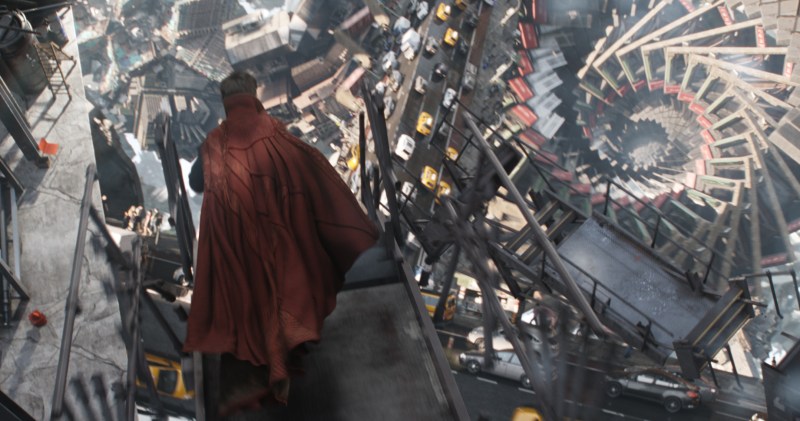Barely two minutes into “Doctor Strange,” Tilda Swinton is fighting bad guys with fire energy in a spinning, contorting London landscape, all while wearing what looks like a yellow raincoat.
Wait, what?
The film’s protagonist, Doctor Stephen Strange (Benedict Cumberbatch) is a Benedict Cumberbatch-esque character. He’s arrogant, prickly, immensely talented. He’s also a surgeon who spends his days proving his wit in the operating room, pushing away his ambiguously-defined “friend” Christine Palmer (Rachel McAdams). He only cares about his wristwatches, his reputation and his money — until the day when he decides to take his fancy sports car out for a spin. His downfall is nothing less than distracted driving, which lands him in a river, his car smashed and the nerve endings in his hands completely torn up. Not very good for a surgeon.
Desperate for an immediate solution, Stephen discovers someone whose paralysis was miraculously cured and is told to go to somewhere called Kamar-Taj — which happens to be in Kathmandu, Nepal. Because “Doctor Strange” is clearly set up to be an origin story, it’s tough to argue that there could possibly be a different progression of events. But comparing this to the origin stories of Captain America, the Hulk and Iron Man, something just doesn’t feel right. The film tries too hard to reintroduce Swinton’s character, the Ancient One, and mostly glances over what is often considered to be such a vital part of the Marvel film formula: the protagonist’s struggle to discover his real potential. There’s only one true moment of that nature, when the Ancient One leaves Doctor Strange stranded on Mount Everest with the intent of forcing him to conjure up a portal to leave. If Strange fails, he’ll freeze to death. But we don’t see Strange conjure anything. We only see that he gets back, snow encrusted in his beard.
It’s not the only element of the film that’s off. “Doctor Strange” is the Marvel Cinematic Universe’s first film based around the concept of magic — or more specifically, Eastern mysticism. If you’ve been on the Internet in the past six months, you’ve most likely heard about the whitewashing scandal surrounding the casting of Tilda Swinton, whose character in the comics was a Tibetan farmer. Swinton’s performance was admittedly entertaining, but I cringed when one of the Ancient One’s disciples, Mordo (Chiwetel Ejiofor), tells Doctor Strange that nothing more is known about her “except that she’s Celtic” and really, really old.
Okay, Marvel, we get it. We get your justification. We really do. But the brazen, bald, British actress wearing a mystical-looking Asian robe, repeatedly telling Doctor Strange to “forget everything that you think you know” and to “open your mind” while being filmed in an actual Nepalese temple just feels oddly out of place, setting an uncomfortable tone for the rest of the movie.
Nevertheless, the film’s shortcomings are at least partially made up by its stunning visual effects. There’s something indescribably ecstatic about the kaleidoscope of buildings that plays with your mind. They’re “Interstellar”-level effects that can only be described as trippy. When the Ancient One pushes Doctor Strange’s “astral form” out of his body and he goes tumbling through other dimensions, hurtling through expanding, fractal-like geometric shapes, it’s easy to just give in to the spectacle.
Words can’t even begin to describe the many fight scenes that take visual effects to the next level — duplicated versions of cityscapes bent at right angles surround the characters as they jump from plane to plane, matter swirling around them, bending the very essence of reality. It’s just something that you have to experience for yourself. Preferably in 3D.
But despite the outrageous nature of some of the images, Marvel still finds a way to successfully fold the movie back into the greater MCU. It’s been nearly 10 years since Marvel started this experiment, and at this point, it should be lauded for its commitment to maintaining an extraordinarily continuous timeline — something which neither Warner Bros. nor Fox has been completely able to do with their comic-book franchises — and for its ability to connect its films together while still allowing each individual project to breathe on its own. Even if it’s just through a side comment about an Infinity Stone or a post-credits scene that everyone should stay in the theater to watch, the effort is appreciated.
No matter if you’re a seasoned Marvel devotee or a newbie to this particular cinematic comic universe, you will probably find something special about seeing ‘Doctor Strange.” Especially if you see it in 3D. It might not be the best movie of the year; it might not even be Marvel’s best movie. But it’s still a pretty good film.
Contact Olivia Popp at opopp ‘at’ stanford.edu.
